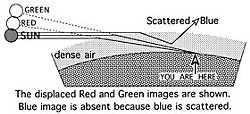[
{
"name": "Top Stories Video Pair",
"insertPoint": "7",
"component": "17087298",
"parentWrapperClass": "fdn-ads-inline-content-block",
"requiredCountToDisplay": "1"
}
]
If you watch the red sun just before it disappears below the sea’s horizon you may see a flash of green. Gene Callahan, a local builder of fine homes, tells me that a red road flare will turn green if stared at long enough. These phenomena are actually quite different. Gene’s green is a result of the bleaching of red-absorbing pigments in his retinal cone cells. The Green Flash, on the other hand, can be photographed. It results from two physical properties of light: refraction and scattering.
An example of refraction is the bending of light by a glass prism, which produces a rainbow of colors because blue rays bend the most, red the least. You can investigate scattering by adding a few drops of milk to a glass of water. Illuminated from the side, the scattered light appears bluish, whereas light transmitted through the liquid is tinted orange (depleted in blue). Blue light scatters more readily from tiny particles than does red light, with its longer wavelength. The sky is blue because air molecules scatter blue. The setting sun is red because its light has traveled through much blue-scattering air. (Be sure to look at the diagrams below.)
The “Green Flash” is best observed when a temperature inversion separates cold, dense marine air from overlying warm air. My exaggerated diagram shows the relative refraction of red, green and blue rays from a setting sun, the consequent displacement of red and green images of the sun, and the absence of a blue image because blue light is removed by scattering within the atmosphere. The increased refraction of green light relative to red allows the observer to see a fringe of green on top of the red immediately before the sun disappears. Green is the fortunate compromise between sufficient refraction and loss by scattering. Of course, as color is continuous between the three described above, you will find yellow in some photos of the flash.
Your enjoyment of the setting sun is a consequence of an accidental mutation in an ancient ancestor. Here is the story: During the reign of dinosaurs, ending 65 million years ago, mammals were wisely nocturnal. Retinal rod cells are best in moonlight but don’t sense color, so mammalian color-sensing pigments degraded to just those absorbing blue and yellow. Fortunately, about 35 million years ago, long after dinosaur extinction and the separation of America from Africa, an Old World primate’s gene underwent a duplication event. That gene encoded the yellow-absorbing pigment. The two copies subsequently evolved to direct the production of two different pigments, one that preferentially absorbs red light, the other green. Our retinas evolved to utilize both pigments, while retaining the pre-existing blue-absorbing cone cells. Old World primates thus enjoy three types of cone cell (blue, green and red), whereas most mammals are stuck with just two (blue and yellow).
Unfortunately, the red and green genes are located on the X chromosome, so XY males have no back-up copies. About 8 percent of human males cannot distinguish red from green.
Take your dog to the beach and look for the elusive Green Flash, but don’t bleach your retina and don’t be disappointed if your two-coned dog finds alternative distractions.
Don Garlick is a geology professor retired from HSU. He invites any questions relating to North Coast science, and if he cannot answer it he will find an expert who can. E-mail [email protected].
Speaking of Science
-

HSU Expanding Curriculum with Polytechnic Push
Jun 15, 2021 -

Davos Won't Save Us
Jan 23, 2020 -

The Need to Study Weed
Jan 16, 2020 - More »
more from the author
-
Nuclear Matters
- May 6, 2010
-
Sophie Smells a Shaker
- Feb 4, 2010
-
The Roots of Love
- Feb 5, 2009
- More »
































